Ethics and Reflexive Practice Essay 2022
VerifiedAdded on 2022/10/01
|11
|2812
|15
Essay
AI Summary
Contribute Materials
Your contribution can guide someone’s learning journey. Share your
documents today.
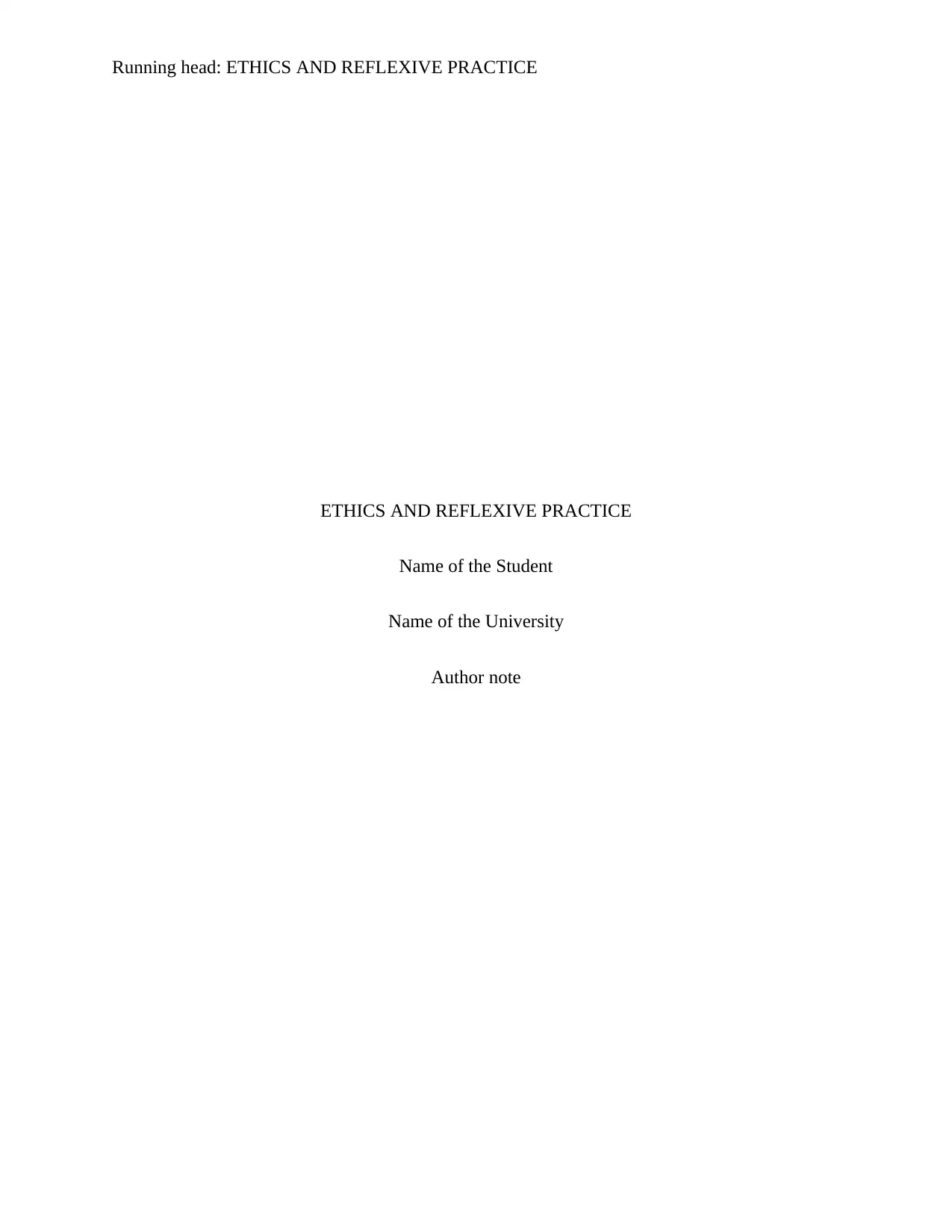
Running head: ETHICS AND REFLEXIVE PRACTICE
ETHICS AND REFLEXIVE PRACTICE
Name of the Student
Name of the University
Author note
ETHICS AND REFLEXIVE PRACTICE
Name of the Student
Name of the University
Author note
Secure Best Marks with AI Grader
Need help grading? Try our AI Grader for instant feedback on your assignments.
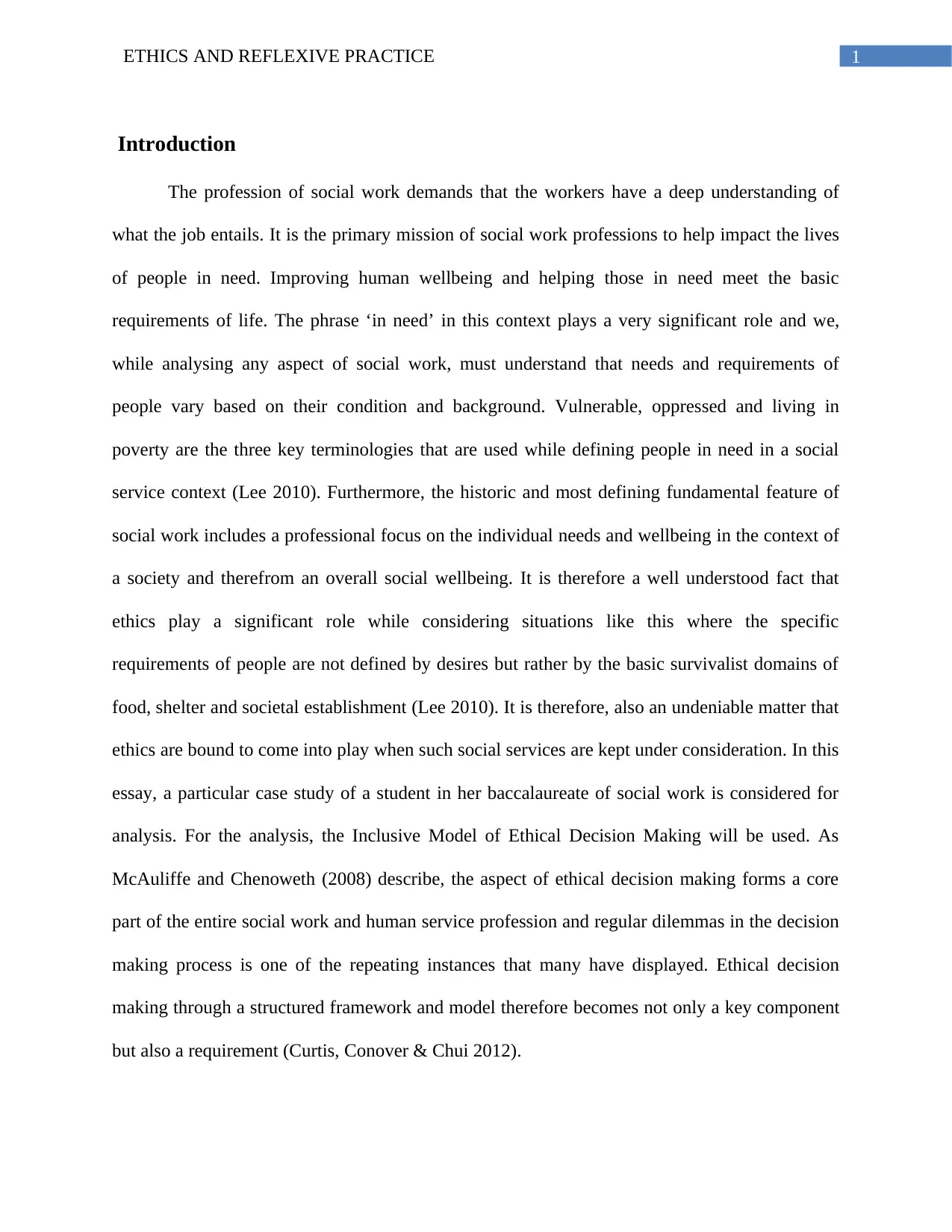
1ETHICS AND REFLEXIVE PRACTICE
Introduction
The profession of social work demands that the workers have a deep understanding of
what the job entails. It is the primary mission of social work professions to help impact the lives
of people in need. Improving human wellbeing and helping those in need meet the basic
requirements of life. The phrase ‘in need’ in this context plays a very significant role and we,
while analysing any aspect of social work, must understand that needs and requirements of
people vary based on their condition and background. Vulnerable, oppressed and living in
poverty are the three key terminologies that are used while defining people in need in a social
service context (Lee 2010). Furthermore, the historic and most defining fundamental feature of
social work includes a professional focus on the individual needs and wellbeing in the context of
a society and therefrom an overall social wellbeing. It is therefore a well understood fact that
ethics play a significant role while considering situations like this where the specific
requirements of people are not defined by desires but rather by the basic survivalist domains of
food, shelter and societal establishment (Lee 2010). It is therefore, also an undeniable matter that
ethics are bound to come into play when such social services are kept under consideration. In this
essay, a particular case study of a student in her baccalaureate of social work is considered for
analysis. For the analysis, the Inclusive Model of Ethical Decision Making will be used. As
McAuliffe and Chenoweth (2008) describe, the aspect of ethical decision making forms a core
part of the entire social work and human service profession and regular dilemmas in the decision
making process is one of the repeating instances that many have displayed. Ethical decision
making through a structured framework and model therefore becomes not only a key component
but also a requirement (Curtis, Conover & Chui 2012).
Introduction
The profession of social work demands that the workers have a deep understanding of
what the job entails. It is the primary mission of social work professions to help impact the lives
of people in need. Improving human wellbeing and helping those in need meet the basic
requirements of life. The phrase ‘in need’ in this context plays a very significant role and we,
while analysing any aspect of social work, must understand that needs and requirements of
people vary based on their condition and background. Vulnerable, oppressed and living in
poverty are the three key terminologies that are used while defining people in need in a social
service context (Lee 2010). Furthermore, the historic and most defining fundamental feature of
social work includes a professional focus on the individual needs and wellbeing in the context of
a society and therefrom an overall social wellbeing. It is therefore a well understood fact that
ethics play a significant role while considering situations like this where the specific
requirements of people are not defined by desires but rather by the basic survivalist domains of
food, shelter and societal establishment (Lee 2010). It is therefore, also an undeniable matter that
ethics are bound to come into play when such social services are kept under consideration. In this
essay, a particular case study of a student in her baccalaureate of social work is considered for
analysis. For the analysis, the Inclusive Model of Ethical Decision Making will be used. As
McAuliffe and Chenoweth (2008) describe, the aspect of ethical decision making forms a core
part of the entire social work and human service profession and regular dilemmas in the decision
making process is one of the repeating instances that many have displayed. Ethical decision
making through a structured framework and model therefore becomes not only a key component
but also a requirement (Curtis, Conover & Chui 2012).
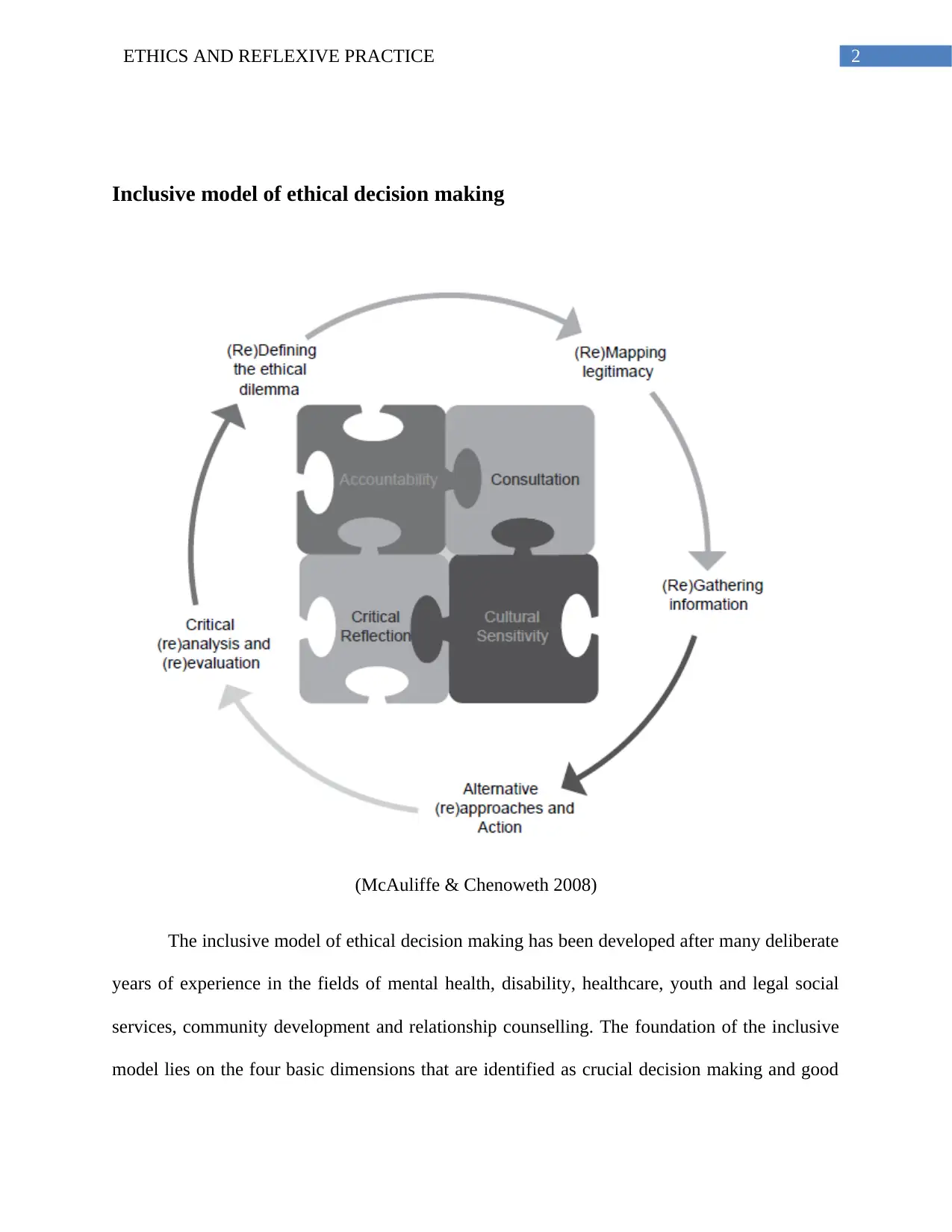
2ETHICS AND REFLEXIVE PRACTICE
Inclusive model of ethical decision making
(McAuliffe & Chenoweth 2008)
The inclusive model of ethical decision making has been developed after many deliberate
years of experience in the fields of mental health, disability, healthcare, youth and legal social
services, community development and relationship counselling. The foundation of the inclusive
model lies on the four basic dimensions that are identified as crucial decision making and good
Inclusive model of ethical decision making
(McAuliffe & Chenoweth 2008)
The inclusive model of ethical decision making has been developed after many deliberate
years of experience in the fields of mental health, disability, healthcare, youth and legal social
services, community development and relationship counselling. The foundation of the inclusive
model lies on the four basic dimensions that are identified as crucial decision making and good
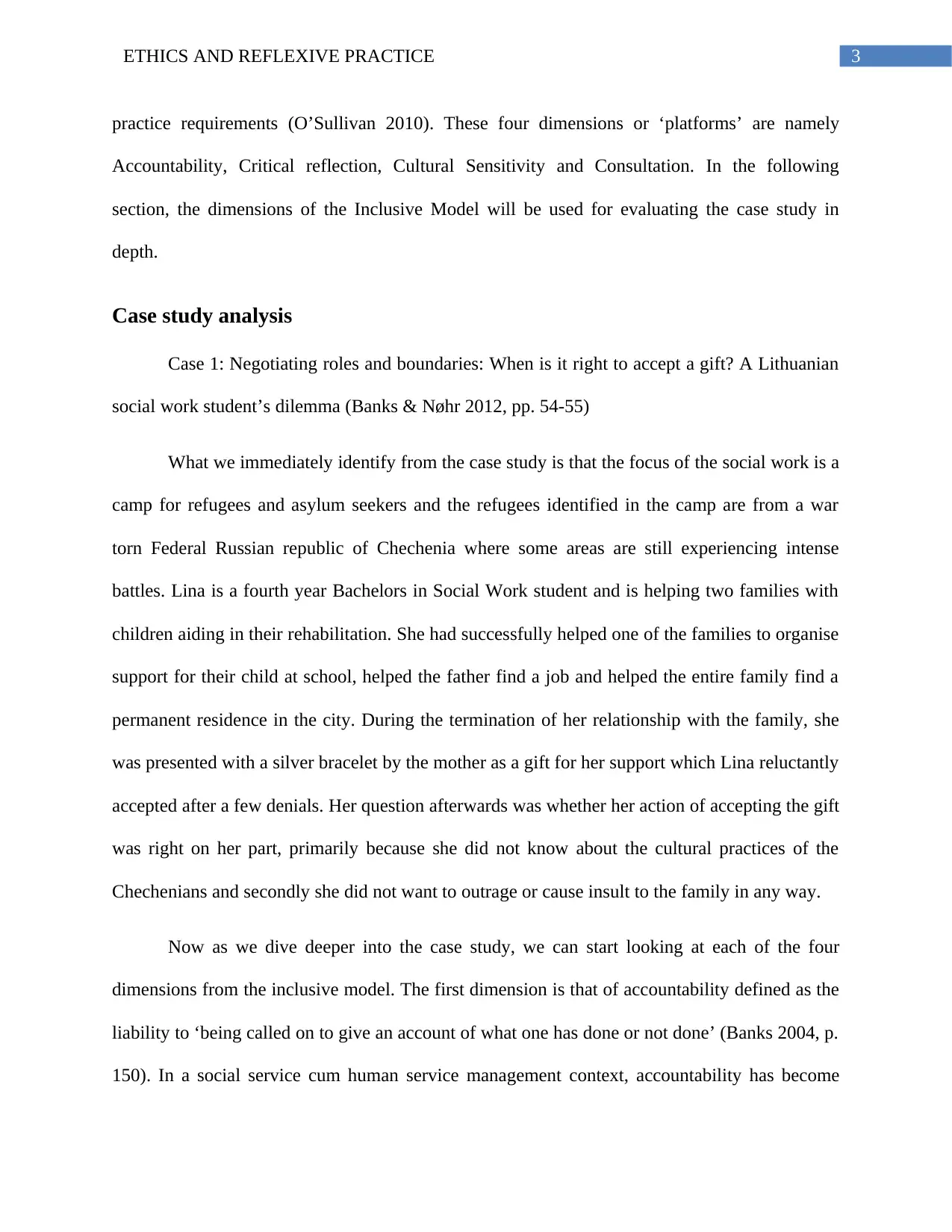
3ETHICS AND REFLEXIVE PRACTICE
practice requirements (O’Sullivan 2010). These four dimensions or ‘platforms’ are namely
Accountability, Critical reflection, Cultural Sensitivity and Consultation. In the following
section, the dimensions of the Inclusive Model will be used for evaluating the case study in
depth.
Case study analysis
Case 1: Negotiating roles and boundaries: When is it right to accept a gift? A Lithuanian
social work student’s dilemma (Banks & Nøhr 2012, pp. 54-55)
What we immediately identify from the case study is that the focus of the social work is a
camp for refugees and asylum seekers and the refugees identified in the camp are from a war
torn Federal Russian republic of Chechenia where some areas are still experiencing intense
battles. Lina is a fourth year Bachelors in Social Work student and is helping two families with
children aiding in their rehabilitation. She had successfully helped one of the families to organise
support for their child at school, helped the father find a job and helped the entire family find a
permanent residence in the city. During the termination of her relationship with the family, she
was presented with a silver bracelet by the mother as a gift for her support which Lina reluctantly
accepted after a few denials. Her question afterwards was whether her action of accepting the gift
was right on her part, primarily because she did not know about the cultural practices of the
Chechenians and secondly she did not want to outrage or cause insult to the family in any way.
Now as we dive deeper into the case study, we can start looking at each of the four
dimensions from the inclusive model. The first dimension is that of accountability defined as the
liability to ‘being called on to give an account of what one has done or not done’ (Banks 2004, p.
150). In a social service cum human service management context, accountability has become
practice requirements (O’Sullivan 2010). These four dimensions or ‘platforms’ are namely
Accountability, Critical reflection, Cultural Sensitivity and Consultation. In the following
section, the dimensions of the Inclusive Model will be used for evaluating the case study in
depth.
Case study analysis
Case 1: Negotiating roles and boundaries: When is it right to accept a gift? A Lithuanian
social work student’s dilemma (Banks & Nøhr 2012, pp. 54-55)
What we immediately identify from the case study is that the focus of the social work is a
camp for refugees and asylum seekers and the refugees identified in the camp are from a war
torn Federal Russian republic of Chechenia where some areas are still experiencing intense
battles. Lina is a fourth year Bachelors in Social Work student and is helping two families with
children aiding in their rehabilitation. She had successfully helped one of the families to organise
support for their child at school, helped the father find a job and helped the entire family find a
permanent residence in the city. During the termination of her relationship with the family, she
was presented with a silver bracelet by the mother as a gift for her support which Lina reluctantly
accepted after a few denials. Her question afterwards was whether her action of accepting the gift
was right on her part, primarily because she did not know about the cultural practices of the
Chechenians and secondly she did not want to outrage or cause insult to the family in any way.
Now as we dive deeper into the case study, we can start looking at each of the four
dimensions from the inclusive model. The first dimension is that of accountability defined as the
liability to ‘being called on to give an account of what one has done or not done’ (Banks 2004, p.
150). In a social service cum human service management context, accountability has become
Secure Best Marks with AI Grader
Need help grading? Try our AI Grader for instant feedback on your assignments.
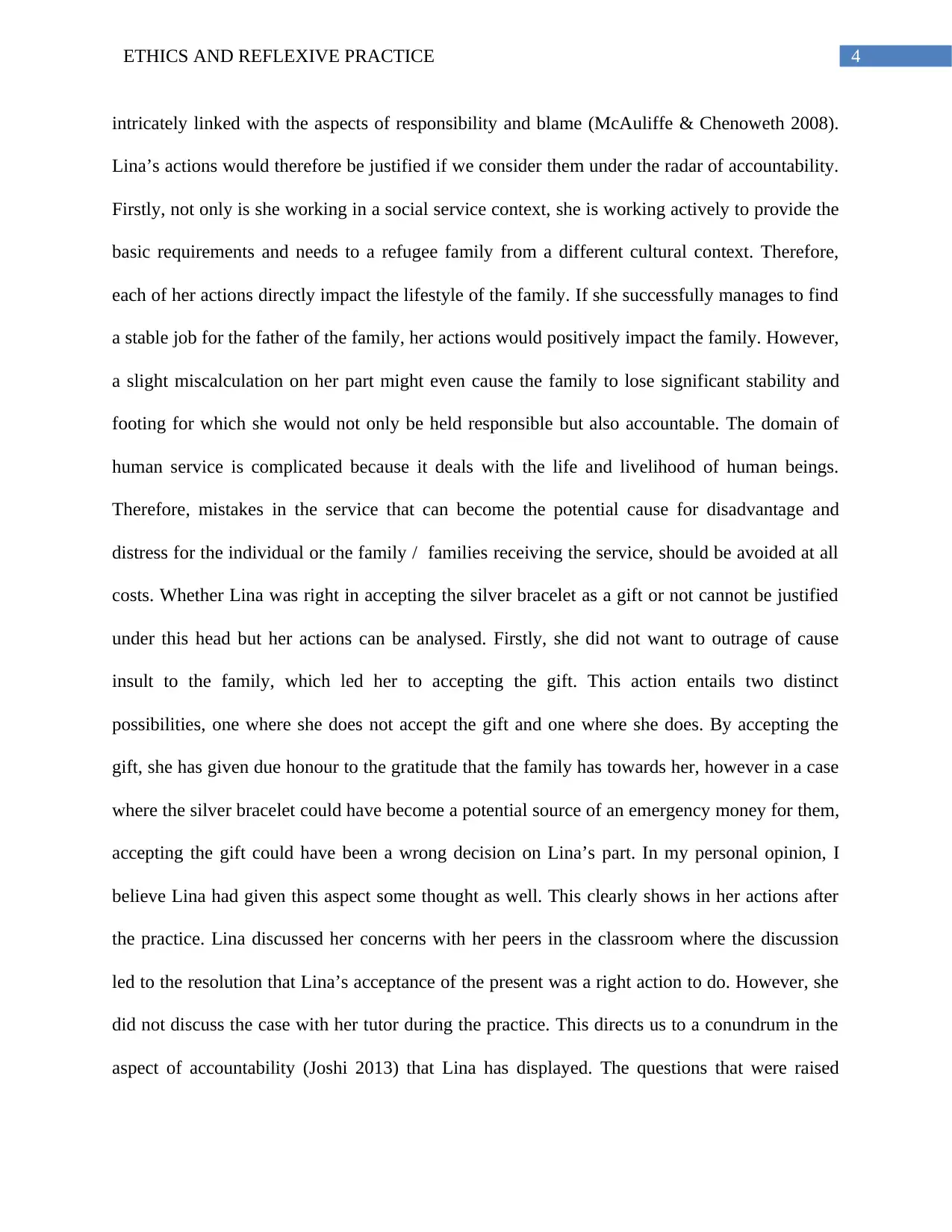
4ETHICS AND REFLEXIVE PRACTICE
intricately linked with the aspects of responsibility and blame (McAuliffe & Chenoweth 2008).
Lina’s actions would therefore be justified if we consider them under the radar of accountability.
Firstly, not only is she working in a social service context, she is working actively to provide the
basic requirements and needs to a refugee family from a different cultural context. Therefore,
each of her actions directly impact the lifestyle of the family. If she successfully manages to find
a stable job for the father of the family, her actions would positively impact the family. However,
a slight miscalculation on her part might even cause the family to lose significant stability and
footing for which she would not only be held responsible but also accountable. The domain of
human service is complicated because it deals with the life and livelihood of human beings.
Therefore, mistakes in the service that can become the potential cause for disadvantage and
distress for the individual or the family / families receiving the service, should be avoided at all
costs. Whether Lina was right in accepting the silver bracelet as a gift or not cannot be justified
under this head but her actions can be analysed. Firstly, she did not want to outrage of cause
insult to the family, which led her to accepting the gift. This action entails two distinct
possibilities, one where she does not accept the gift and one where she does. By accepting the
gift, she has given due honour to the gratitude that the family has towards her, however in a case
where the silver bracelet could have become a potential source of an emergency money for them,
accepting the gift could have been a wrong decision on Lina’s part. In my personal opinion, I
believe Lina had given this aspect some thought as well. This clearly shows in her actions after
the practice. Lina discussed her concerns with her peers in the classroom where the discussion
led to the resolution that Lina’s acceptance of the present was a right action to do. However, she
did not discuss the case with her tutor during the practice. This directs us to a conundrum in the
aspect of accountability (Joshi 2013) that Lina has displayed. The questions that were raised
intricately linked with the aspects of responsibility and blame (McAuliffe & Chenoweth 2008).
Lina’s actions would therefore be justified if we consider them under the radar of accountability.
Firstly, not only is she working in a social service context, she is working actively to provide the
basic requirements and needs to a refugee family from a different cultural context. Therefore,
each of her actions directly impact the lifestyle of the family. If she successfully manages to find
a stable job for the father of the family, her actions would positively impact the family. However,
a slight miscalculation on her part might even cause the family to lose significant stability and
footing for which she would not only be held responsible but also accountable. The domain of
human service is complicated because it deals with the life and livelihood of human beings.
Therefore, mistakes in the service that can become the potential cause for disadvantage and
distress for the individual or the family / families receiving the service, should be avoided at all
costs. Whether Lina was right in accepting the silver bracelet as a gift or not cannot be justified
under this head but her actions can be analysed. Firstly, she did not want to outrage of cause
insult to the family, which led her to accepting the gift. This action entails two distinct
possibilities, one where she does not accept the gift and one where she does. By accepting the
gift, she has given due honour to the gratitude that the family has towards her, however in a case
where the silver bracelet could have become a potential source of an emergency money for them,
accepting the gift could have been a wrong decision on Lina’s part. In my personal opinion, I
believe Lina had given this aspect some thought as well. This clearly shows in her actions after
the practice. Lina discussed her concerns with her peers in the classroom where the discussion
led to the resolution that Lina’s acceptance of the present was a right action to do. However, she
did not discuss the case with her tutor during the practice. This directs us to a conundrum in the
aspect of accountability (Joshi 2013) that Lina has displayed. The questions that were raised
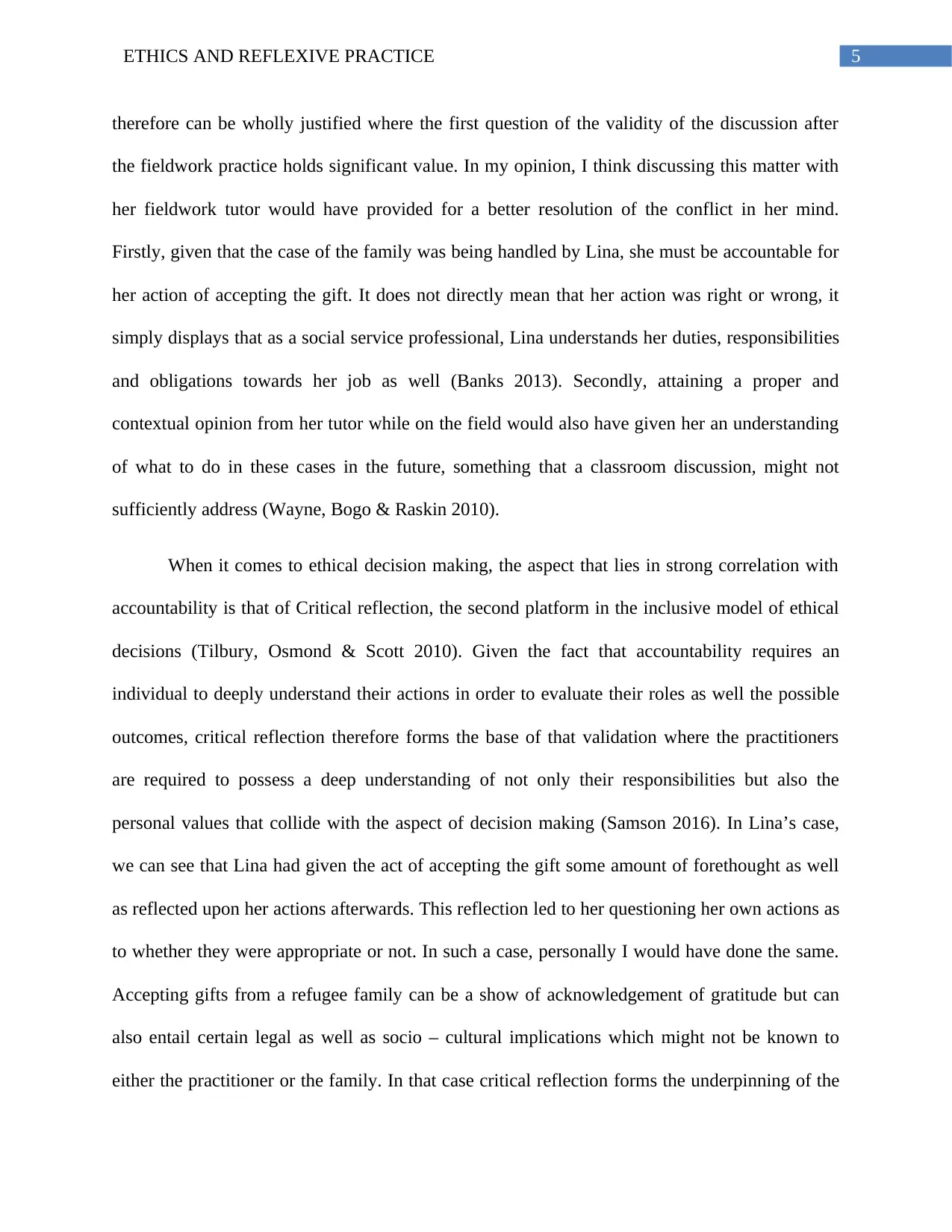
5ETHICS AND REFLEXIVE PRACTICE
therefore can be wholly justified where the first question of the validity of the discussion after
the fieldwork practice holds significant value. In my opinion, I think discussing this matter with
her fieldwork tutor would have provided for a better resolution of the conflict in her mind.
Firstly, given that the case of the family was being handled by Lina, she must be accountable for
her action of accepting the gift. It does not directly mean that her action was right or wrong, it
simply displays that as a social service professional, Lina understands her duties, responsibilities
and obligations towards her job as well (Banks 2013). Secondly, attaining a proper and
contextual opinion from her tutor while on the field would also have given her an understanding
of what to do in these cases in the future, something that a classroom discussion, might not
sufficiently address (Wayne, Bogo & Raskin 2010).
When it comes to ethical decision making, the aspect that lies in strong correlation with
accountability is that of Critical reflection, the second platform in the inclusive model of ethical
decisions (Tilbury, Osmond & Scott 2010). Given the fact that accountability requires an
individual to deeply understand their actions in order to evaluate their roles as well the possible
outcomes, critical reflection therefore forms the base of that validation where the practitioners
are required to possess a deep understanding of not only their responsibilities but also the
personal values that collide with the aspect of decision making (Samson 2016). In Lina’s case,
we can see that Lina had given the act of accepting the gift some amount of forethought as well
as reflected upon her actions afterwards. This reflection led to her questioning her own actions as
to whether they were appropriate or not. In such a case, personally I would have done the same.
Accepting gifts from a refugee family can be a show of acknowledgement of gratitude but can
also entail certain legal as well as socio – cultural implications which might not be known to
either the practitioner or the family. In that case critical reflection forms the underpinning of the
therefore can be wholly justified where the first question of the validity of the discussion after
the fieldwork practice holds significant value. In my opinion, I think discussing this matter with
her fieldwork tutor would have provided for a better resolution of the conflict in her mind.
Firstly, given that the case of the family was being handled by Lina, she must be accountable for
her action of accepting the gift. It does not directly mean that her action was right or wrong, it
simply displays that as a social service professional, Lina understands her duties, responsibilities
and obligations towards her job as well (Banks 2013). Secondly, attaining a proper and
contextual opinion from her tutor while on the field would also have given her an understanding
of what to do in these cases in the future, something that a classroom discussion, might not
sufficiently address (Wayne, Bogo & Raskin 2010).
When it comes to ethical decision making, the aspect that lies in strong correlation with
accountability is that of Critical reflection, the second platform in the inclusive model of ethical
decisions (Tilbury, Osmond & Scott 2010). Given the fact that accountability requires an
individual to deeply understand their actions in order to evaluate their roles as well the possible
outcomes, critical reflection therefore forms the base of that validation where the practitioners
are required to possess a deep understanding of not only their responsibilities but also the
personal values that collide with the aspect of decision making (Samson 2016). In Lina’s case,
we can see that Lina had given the act of accepting the gift some amount of forethought as well
as reflected upon her actions afterwards. This reflection led to her questioning her own actions as
to whether they were appropriate or not. In such a case, personally I would have done the same.
Accepting gifts from a refugee family can be a show of acknowledgement of gratitude but can
also entail certain legal as well as socio – cultural implications which might not be known to
either the practitioner or the family. In that case critical reflection forms the underpinning of the
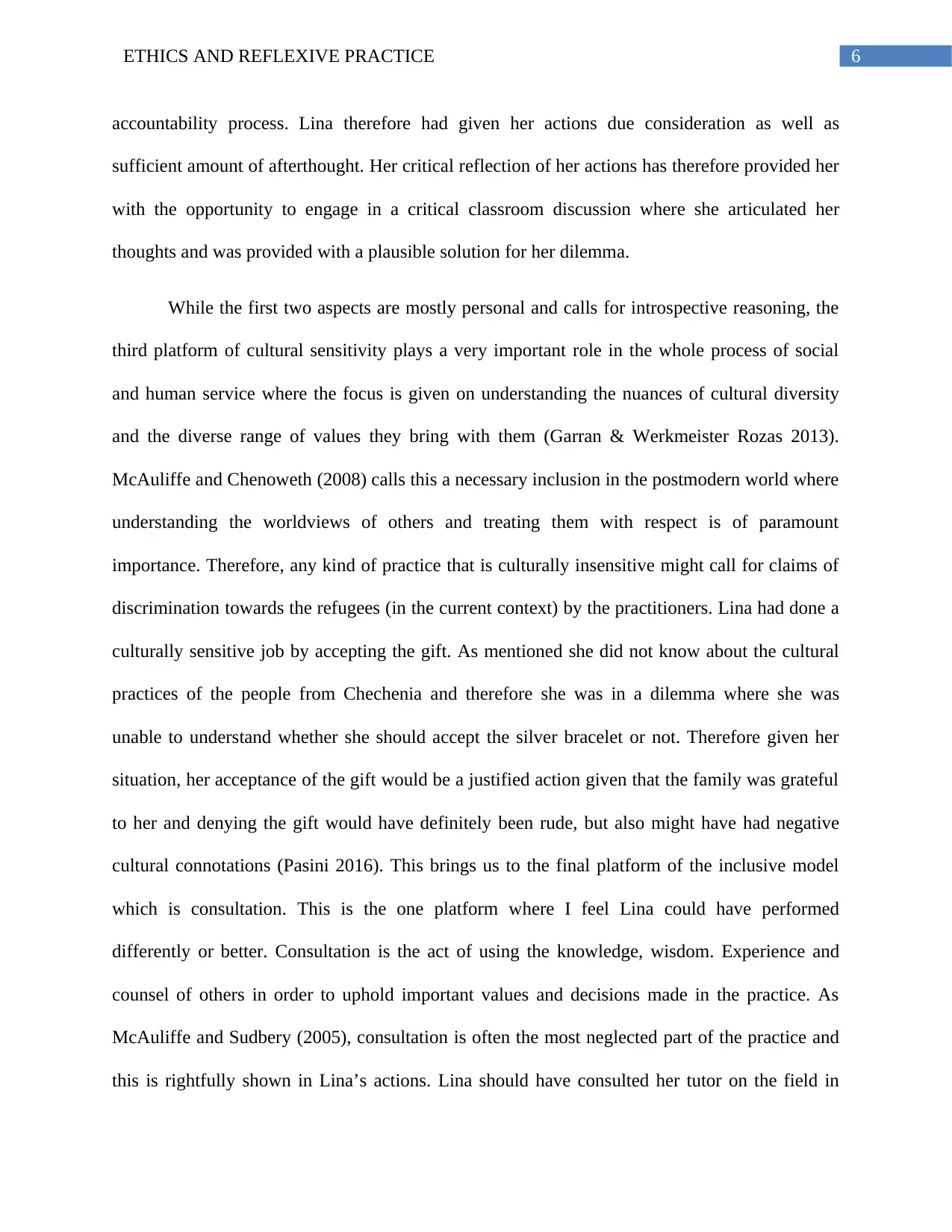
6ETHICS AND REFLEXIVE PRACTICE
accountability process. Lina therefore had given her actions due consideration as well as
sufficient amount of afterthought. Her critical reflection of her actions has therefore provided her
with the opportunity to engage in a critical classroom discussion where she articulated her
thoughts and was provided with a plausible solution for her dilemma.
While the first two aspects are mostly personal and calls for introspective reasoning, the
third platform of cultural sensitivity plays a very important role in the whole process of social
and human service where the focus is given on understanding the nuances of cultural diversity
and the diverse range of values they bring with them (Garran & Werkmeister Rozas 2013).
McAuliffe and Chenoweth (2008) calls this a necessary inclusion in the postmodern world where
understanding the worldviews of others and treating them with respect is of paramount
importance. Therefore, any kind of practice that is culturally insensitive might call for claims of
discrimination towards the refugees (in the current context) by the practitioners. Lina had done a
culturally sensitive job by accepting the gift. As mentioned she did not know about the cultural
practices of the people from Chechenia and therefore she was in a dilemma where she was
unable to understand whether she should accept the silver bracelet or not. Therefore given her
situation, her acceptance of the gift would be a justified action given that the family was grateful
to her and denying the gift would have definitely been rude, but also might have had negative
cultural connotations (Pasini 2016). This brings us to the final platform of the inclusive model
which is consultation. This is the one platform where I feel Lina could have performed
differently or better. Consultation is the act of using the knowledge, wisdom. Experience and
counsel of others in order to uphold important values and decisions made in the practice. As
McAuliffe and Sudbery (2005), consultation is often the most neglected part of the practice and
this is rightfully shown in Lina’s actions. Lina should have consulted her tutor on the field in
accountability process. Lina therefore had given her actions due consideration as well as
sufficient amount of afterthought. Her critical reflection of her actions has therefore provided her
with the opportunity to engage in a critical classroom discussion where she articulated her
thoughts and was provided with a plausible solution for her dilemma.
While the first two aspects are mostly personal and calls for introspective reasoning, the
third platform of cultural sensitivity plays a very important role in the whole process of social
and human service where the focus is given on understanding the nuances of cultural diversity
and the diverse range of values they bring with them (Garran & Werkmeister Rozas 2013).
McAuliffe and Chenoweth (2008) calls this a necessary inclusion in the postmodern world where
understanding the worldviews of others and treating them with respect is of paramount
importance. Therefore, any kind of practice that is culturally insensitive might call for claims of
discrimination towards the refugees (in the current context) by the practitioners. Lina had done a
culturally sensitive job by accepting the gift. As mentioned she did not know about the cultural
practices of the people from Chechenia and therefore she was in a dilemma where she was
unable to understand whether she should accept the silver bracelet or not. Therefore given her
situation, her acceptance of the gift would be a justified action given that the family was grateful
to her and denying the gift would have definitely been rude, but also might have had negative
cultural connotations (Pasini 2016). This brings us to the final platform of the inclusive model
which is consultation. This is the one platform where I feel Lina could have performed
differently or better. Consultation is the act of using the knowledge, wisdom. Experience and
counsel of others in order to uphold important values and decisions made in the practice. As
McAuliffe and Sudbery (2005), consultation is often the most neglected part of the practice and
this is rightfully shown in Lina’s actions. Lina should have consulted her tutor on the field in
Paraphrase This Document
Need a fresh take? Get an instant paraphrase of this document with our AI Paraphraser
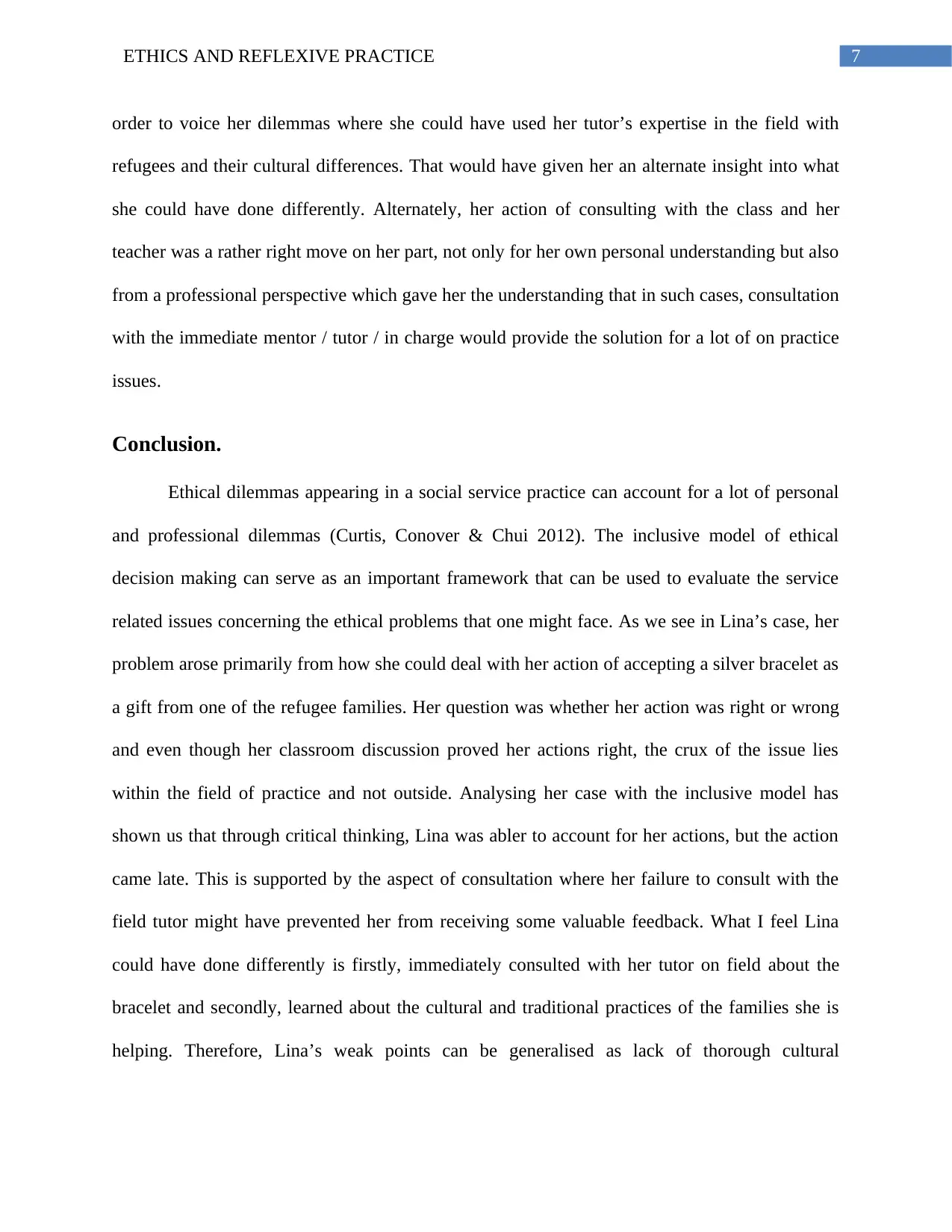
7ETHICS AND REFLEXIVE PRACTICE
order to voice her dilemmas where she could have used her tutor’s expertise in the field with
refugees and their cultural differences. That would have given her an alternate insight into what
she could have done differently. Alternately, her action of consulting with the class and her
teacher was a rather right move on her part, not only for her own personal understanding but also
from a professional perspective which gave her the understanding that in such cases, consultation
with the immediate mentor / tutor / in charge would provide the solution for a lot of on practice
issues.
Conclusion.
Ethical dilemmas appearing in a social service practice can account for a lot of personal
and professional dilemmas (Curtis, Conover & Chui 2012). The inclusive model of ethical
decision making can serve as an important framework that can be used to evaluate the service
related issues concerning the ethical problems that one might face. As we see in Lina’s case, her
problem arose primarily from how she could deal with her action of accepting a silver bracelet as
a gift from one of the refugee families. Her question was whether her action was right or wrong
and even though her classroom discussion proved her actions right, the crux of the issue lies
within the field of practice and not outside. Analysing her case with the inclusive model has
shown us that through critical thinking, Lina was abler to account for her actions, but the action
came late. This is supported by the aspect of consultation where her failure to consult with the
field tutor might have prevented her from receiving some valuable feedback. What I feel Lina
could have done differently is firstly, immediately consulted with her tutor on field about the
bracelet and secondly, learned about the cultural and traditional practices of the families she is
helping. Therefore, Lina’s weak points can be generalised as lack of thorough cultural
order to voice her dilemmas where she could have used her tutor’s expertise in the field with
refugees and their cultural differences. That would have given her an alternate insight into what
she could have done differently. Alternately, her action of consulting with the class and her
teacher was a rather right move on her part, not only for her own personal understanding but also
from a professional perspective which gave her the understanding that in such cases, consultation
with the immediate mentor / tutor / in charge would provide the solution for a lot of on practice
issues.
Conclusion.
Ethical dilemmas appearing in a social service practice can account for a lot of personal
and professional dilemmas (Curtis, Conover & Chui 2012). The inclusive model of ethical
decision making can serve as an important framework that can be used to evaluate the service
related issues concerning the ethical problems that one might face. As we see in Lina’s case, her
problem arose primarily from how she could deal with her action of accepting a silver bracelet as
a gift from one of the refugee families. Her question was whether her action was right or wrong
and even though her classroom discussion proved her actions right, the crux of the issue lies
within the field of practice and not outside. Analysing her case with the inclusive model has
shown us that through critical thinking, Lina was abler to account for her actions, but the action
came late. This is supported by the aspect of consultation where her failure to consult with the
field tutor might have prevented her from receiving some valuable feedback. What I feel Lina
could have done differently is firstly, immediately consulted with her tutor on field about the
bracelet and secondly, learned about the cultural and traditional practices of the families she is
helping. Therefore, Lina’s weak points can be generalised as lack of thorough cultural
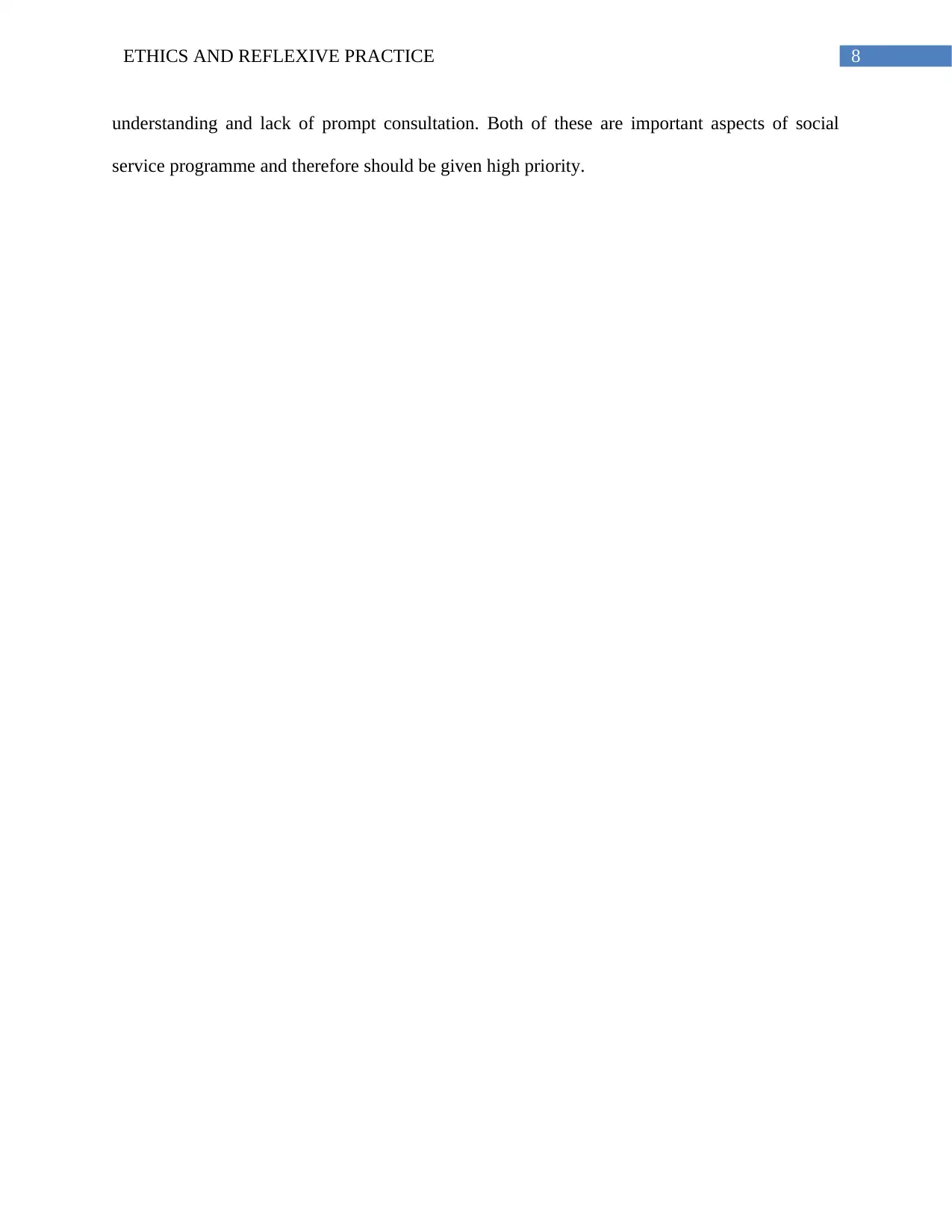
8ETHICS AND REFLEXIVE PRACTICE
understanding and lack of prompt consultation. Both of these are important aspects of social
service programme and therefore should be given high priority.
understanding and lack of prompt consultation. Both of these are important aspects of social
service programme and therefore should be given high priority.
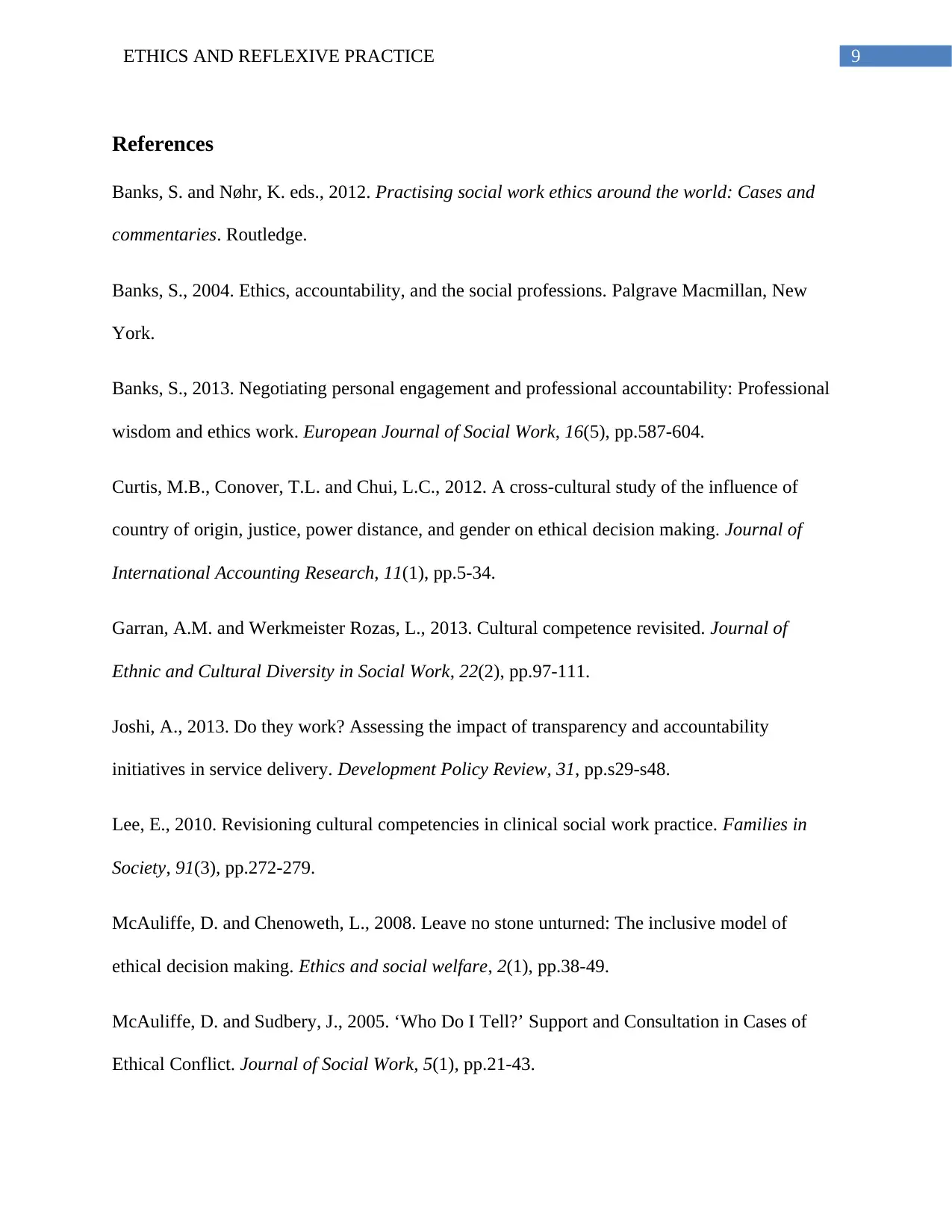
9ETHICS AND REFLEXIVE PRACTICE
References
Banks, S. and Nøhr, K. eds., 2012. Practising social work ethics around the world: Cases and
commentaries. Routledge.
Banks, S., 2004. Ethics, accountability, and the social professions. Palgrave Macmillan, New
York.
Banks, S., 2013. Negotiating personal engagement and professional accountability: Professional
wisdom and ethics work. European Journal of Social Work, 16(5), pp.587-604.
Curtis, M.B., Conover, T.L. and Chui, L.C., 2012. A cross-cultural study of the influence of
country of origin, justice, power distance, and gender on ethical decision making. Journal of
International Accounting Research, 11(1), pp.5-34.
Garran, A.M. and Werkmeister Rozas, L., 2013. Cultural competence revisited. Journal of
Ethnic and Cultural Diversity in Social Work, 22(2), pp.97-111.
Joshi, A., 2013. Do they work? Assessing the impact of transparency and accountability
initiatives in service delivery. Development Policy Review, 31, pp.s29-s48.
Lee, E., 2010. Revisioning cultural competencies in clinical social work practice. Families in
Society, 91(3), pp.272-279.
McAuliffe, D. and Chenoweth, L., 2008. Leave no stone unturned: The inclusive model of
ethical decision making. Ethics and social welfare, 2(1), pp.38-49.
McAuliffe, D. and Sudbery, J., 2005. ‘Who Do I Tell?’ Support and Consultation in Cases of
Ethical Conflict. Journal of Social Work, 5(1), pp.21-43.
References
Banks, S. and Nøhr, K. eds., 2012. Practising social work ethics around the world: Cases and
commentaries. Routledge.
Banks, S., 2004. Ethics, accountability, and the social professions. Palgrave Macmillan, New
York.
Banks, S., 2013. Negotiating personal engagement and professional accountability: Professional
wisdom and ethics work. European Journal of Social Work, 16(5), pp.587-604.
Curtis, M.B., Conover, T.L. and Chui, L.C., 2012. A cross-cultural study of the influence of
country of origin, justice, power distance, and gender on ethical decision making. Journal of
International Accounting Research, 11(1), pp.5-34.
Garran, A.M. and Werkmeister Rozas, L., 2013. Cultural competence revisited. Journal of
Ethnic and Cultural Diversity in Social Work, 22(2), pp.97-111.
Joshi, A., 2013. Do they work? Assessing the impact of transparency and accountability
initiatives in service delivery. Development Policy Review, 31, pp.s29-s48.
Lee, E., 2010. Revisioning cultural competencies in clinical social work practice. Families in
Society, 91(3), pp.272-279.
McAuliffe, D. and Chenoweth, L., 2008. Leave no stone unturned: The inclusive model of
ethical decision making. Ethics and social welfare, 2(1), pp.38-49.
McAuliffe, D. and Sudbery, J., 2005. ‘Who Do I Tell?’ Support and Consultation in Cases of
Ethical Conflict. Journal of Social Work, 5(1), pp.21-43.
Secure Best Marks with AI Grader
Need help grading? Try our AI Grader for instant feedback on your assignments.
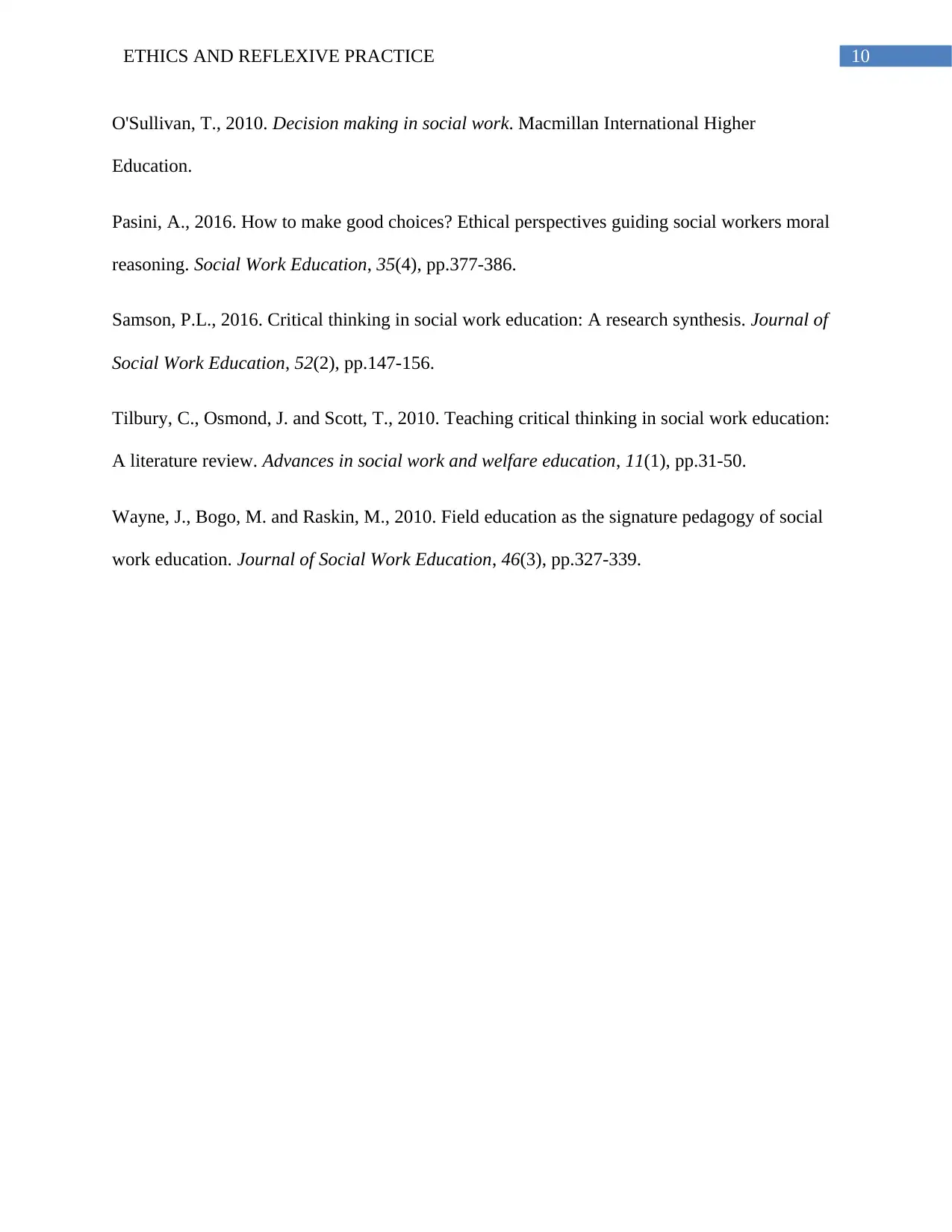
10ETHICS AND REFLEXIVE PRACTICE
O'Sullivan, T., 2010. Decision making in social work. Macmillan International Higher
Education.
Pasini, A., 2016. How to make good choices? Ethical perspectives guiding social workers moral
reasoning. Social Work Education, 35(4), pp.377-386.
Samson, P.L., 2016. Critical thinking in social work education: A research synthesis. Journal of
Social Work Education, 52(2), pp.147-156.
Tilbury, C., Osmond, J. and Scott, T., 2010. Teaching critical thinking in social work education:
A literature review. Advances in social work and welfare education, 11(1), pp.31-50.
Wayne, J., Bogo, M. and Raskin, M., 2010. Field education as the signature pedagogy of social
work education. Journal of Social Work Education, 46(3), pp.327-339.
O'Sullivan, T., 2010. Decision making in social work. Macmillan International Higher
Education.
Pasini, A., 2016. How to make good choices? Ethical perspectives guiding social workers moral
reasoning. Social Work Education, 35(4), pp.377-386.
Samson, P.L., 2016. Critical thinking in social work education: A research synthesis. Journal of
Social Work Education, 52(2), pp.147-156.
Tilbury, C., Osmond, J. and Scott, T., 2010. Teaching critical thinking in social work education:
A literature review. Advances in social work and welfare education, 11(1), pp.31-50.
Wayne, J., Bogo, M. and Raskin, M., 2010. Field education as the signature pedagogy of social
work education. Journal of Social Work Education, 46(3), pp.327-339.
1 out of 11
Related Documents
Your All-in-One AI-Powered Toolkit for Academic Success.
+13062052269
info@desklib.com
Available 24*7 on WhatsApp / Email
![[object Object]](/_next/static/media/star-bottom.7253800d.svg)
Unlock your academic potential
© 2024 | Zucol Services PVT LTD | All rights reserved.




